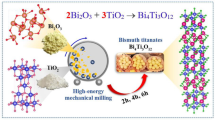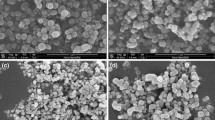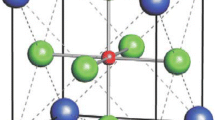Abstract
In an attempt to obtain finest possible microparticles of BaTiO3 (BT) with highest possible tetragonality via a solid state route, starting mixtures comprising BaCO3 and TiO2 were subjected to various pretreatments including addition of glycine and mechanical activation. Reaction processes were monitored by the changes in the weight, crystallinity, and morphology in detail. While mechanical activation with glycine significantly increased the rate of reaction and homogeneity of the particle size of the product, BT, simultaneous particle growth of BT was intolerably acute for micro-electronic devices. The fast particle coarsening was predominated by the coalescence of BT tiny particles formed around titania. A mixture with higher homogeneity was attained by using finer starting materials under wet mixing, avoiding significant mechanical stressing. Particle growth of BT was suppressed to ca. 100 nm to obtain fully crystallized BT particles without significant loss of tetragonality and, hence, close to meet our requirements for MLCCs.













Similar content being viewed by others
References
Mizuno Y, Hagiwara T, Kishi H (2007) J Ceram Soc Jpn 115:360. doi:https://doi.org/10.2109/jcersj.115.360
Arlt G, Hennings D, With G (1985) J Appl Phys 58:1619. doi:https://doi.org/10.1063/1.336051
Dawson WJ (1988) Am Ceram Soc Bull 67:1673
Hennings D, Rosenstein G, Schreinemacher H (1991) J Eur Ceram Soc 8:107. doi:https://doi.org/10.1016/0955-2219(91)90116-H
Wada N (2004) J Soc Powder Technol Jpn 41:35
Hennings DFK, Schreinemacher BS, Schreinemacher H (2001) J Am Ceram Soc 84:2777
Buscaglia MT, Bassoli M, Buscaglia V, Alessio R (2005) J Am Ceram Soc 88:2374. doi:https://doi.org/10.1111/j.1551-2916.2005.00451.x
Ando C, Yanagawa R, Chazono H, Kishi H, Senna M (2004) J Mater Res 19:3592. doi:https://doi.org/10.1557/JMR.2004.0461
Yanagawa R, Sennna M, Ando C, Chazono H, Kishi H (2007) J Am Ceram Soc 90:809. doi:https://doi.org/10.1111/j.1551-2916.2007.01498.x
Ando C, Chazono H, Kishi H (2004) Key Eng Mater 269:161
Oguchi H, Ando C, Chazono H, Kishi H, Senna M (2005) J Phys France IV 128:33
Ando C, Kishi H, Oguchi H, Senna M (2006) J Am Ceram Soc 89:1709. doi:https://doi.org/10.1111/j.1551-2916.2006.00917.x
Kubo T, Kato M, Fujita T (1967) Kogyo Kagaku Zasshi 70:847
Niepce JC, Thomas G (1990) Solid State Ionics 43:69. doi:https://doi.org/10.1016/0167-2738(90)90472-4
Fujikawa Y, Yamane F, Nomura T (2003) J Jpn Soc Powder Metall 50:751
Lotnyk A, Senz S, Hesse D (2006) Solid State Ionics 177:429. doi:https://doi.org/10.1016/j.ssi.2005.12.027
Lotnyk A, Senz S, Hesse D (2007) Acta Mater 55:2671. doi:https://doi.org/10.1016/j.actamat.2006.12.022
(a) Senna M (1993) Solid State Ionics 3:63; (b) Senna M (2001) Mater Sci Eng A 39:304; (c) Senna M (2002) Ann Chim Sci Mat 27:3
Ando C, Tsuzuku K, Kobayashi T, Kishi H, Kuroda S, Senna MJ, Mater Sci: Mater Electron (to appear)
Society of Powder Technology (1994) Particle size analysis and technology. Nikkan-Kogyo Shinbun shya, Tokyo
Izumi F, Ikeda T (2000) Mater Sci Forum 321–324:198
Wakamatsu T, Fujiwara T, Ishihara KN, Shingu PH (2003) J Jpn Soc Powder Metall 48:950
Acknowledgement
The authors are thankful to Mr. T. Hagiwara for Rietveld analysis.
Author information
Authors and Affiliations
Corresponding author
Rights and permissions
About this article
Cite this article
Ando, C., Suzuki, T., Mizuno, Y. et al. Evaluation of additive effects and homogeneity of the starting mixture on the nuclei-growth processes of barium titanate via a solid state route. J Mater Sci 43, 6182–6192 (2008). https://doi.org/10.1007/s10853-008-2932-3
Received:
Accepted:
Published:
Issue Date:
DOI: https://doi.org/10.1007/s10853-008-2932-3




